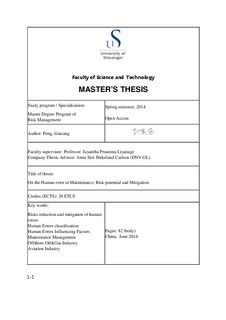| dc.description.abstract | In this thesis, we have firstly reviewed the maintenance management evolution process, meanwhile depends on relevant data and conclusions from other literatures, we found that in general human errors are the causation factors for large number of maintenance failures and the accidents and incidents thereafter, thus human errors become one of the biggest challenges faced by the industry. With the finding we establish the research objectives of the thesis as to firstly identify general patterns of human errors by establishing human error classification system, then try to identify human errors influencing factors of those human errors occurred in the maintenance process, Finally try to examine the management status of those influencing factors in the Norwegian Maintenance management regimes.
We have set our discussion scope mainly on North Sea Oil&Gas Industry; therefore we firstly conducted a survey of North Sea legislation regimes, then legislation regimes of UK and Norway consequently as a background for further discussion. Then we started a theoretical discussion of the natures of human errors, and combined several different human errors classification theories adapted by aviation maintenance industry in order to have complete human errors categories as:
Human conceptual errors: Under this category, we assume that, all the external factors except human themselves are functioning normally, in this circumstance human errors such as slips and lapses, rule based mistakes, knowledge based mistakes and violations are conceptual, and in many case cannot be eliminated due to human nature.
Human errors triggered by external factors: we find that some errors which were directly conducted by a person or a group of people, are actually triggered or induced by external factors, such as environmental factors, technical and organizational factors etc. in other words, if we manage those external factors in the right or better way at the beginning, the human could avoid those mistakes.
Based on the errors classification, we further presented a complete spectrum of human errors’ influencing factors within the maintenance process by complementarily utilization of Boeing’s MEDA and HSE UK’s relevant suggesting as shown at Table 17 Thesis Human Errors influencing factors. Finally we tried to reflect those human errors influencing factors into the maintenance management regime on NCS through reviewing of the Activities Regulations, MBS as well as Audit Reports and RNNP reports issued by PSA.
Potential mitigation measures for Human errors on NCS has been suggested by the author according to the framework of Table 17 thesis human errors influencing factors | nb_NO |
